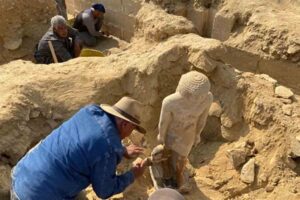In a press conference, Hawass said the finds date from the fifth and sixth dynasties, which correspond to the 25th to the 22nd centuries B.C.
The largest and most important tomb uncovered by scientists is believed to have belonged to a priest inspector and supervisor of nobles named Khnumdjedef, Hawass added.
Another discovered tomb belonged toman identified as the pharaoh´s secret keeper. This refers to a priestly title which senior palace officials held.
“Unfortunately, the expedition did not find any inscriptions that could identify the owner of those statues,” he noted.
However, he detailed that several months after the original finds, experts found a false door nearby, whose owner was named Messi.
Hawass claimed that one of the most important findings was hidden in a 15-meter deep well, which inside kept a large rectangular limestone sarcophagus.
The inscriptions carved on the top of it revealed that the name of its owner was Hekashepes and upon opening it they found a mummy of a man covered in gold leaf.
This is one of the oldest and best preserved, next to the royal mummies, Hawass stressed.
pll/ro/rob









